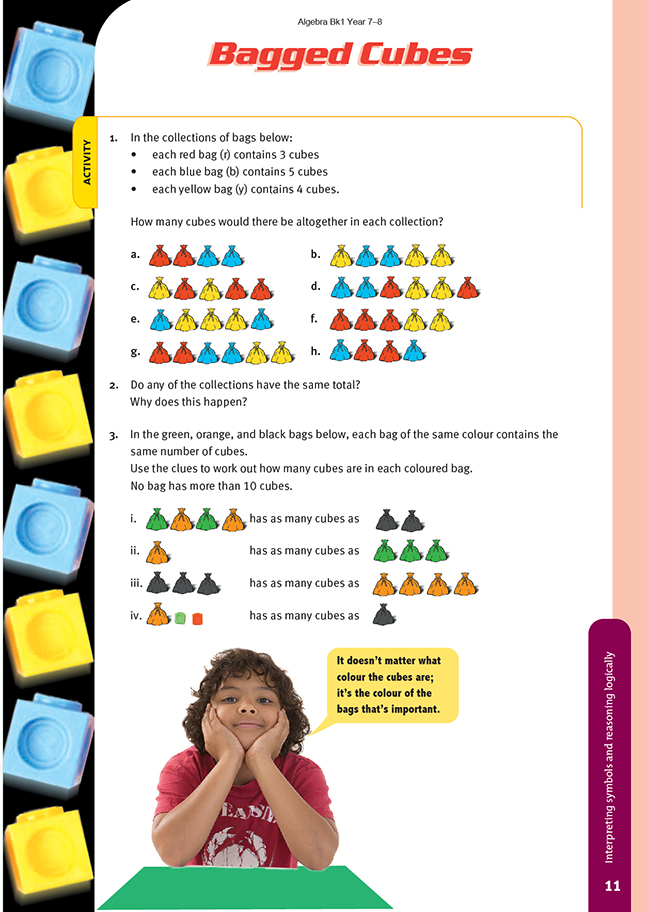This is a level 3 algebra strand link activity from the Figure It Out series.
A PDF of the student activity is included.
Click on the image to enlarge it. Click again to close. Download PDF (209 KB)
use algebraic symbols in linear equations
FIO, Link, Algebra, Book One, Bagged Cubes, page 11
This activity requires students to evaluate equations that are represented symbolically and, in question 3, to solve a series of linear equations.
In question 1, the students substitute 3 for r, 5 for b, and 4 for y. Here, r stands for the number of cubes in the red bag, b stands for the number of cubes in the blue bag, and y stands for the number of cubes in the yellow bag. So, in 1a, the total number of cubes represented by the bag diagram shown below is 3 + 3 + 5 + 5 = 16.
In question 1h, the bag diagram is:
The total number of cubes in these bags is 5 + 3 + 3 + 5 = 16, which is the same as the total number of cubes in the bags shown in question 1a. Only the order has changed. Whichever diagram is used, there are 2 red bags and 2 blue bags and a total of 16 cubes.
Question 3 is considerably more challenging, and the students have to find a way to deduce (logically reason) the number of cubes in each bag. They will probably do best if they begin with clues iii and iv because these two equations both involve only two (and the same two) unknown quantities: in this case, black and orange but not green.
So each black bag shown for clue iii can be replaced by 1 orange bag and 2 extra cubes. So,
The students can deduce from this that 1 orange bag has 6 cubes. Each black bag has 2 more cubes than an orange bag (clue iv), so there are 6 + 2 = 8 cubes in each black bag. In clue iii, 1 orange bag is equivalent to 3 green bags. So each green bag has 6 ÷ 3 = 2 cubes. Note that although clue i is not needed to solve this puzzle, it is consistent with the other clues, that is, the solution satisfies the equation 6 + 2 + 6 + 2 = 8 + 8. Note also that the clues are effectively symbolic equations. For example, we could represent clue i as g + o + g + o = b + b or 2g + 2o = 2b.
If necessary, you could assist students who are struggling with question 3 by telling them the number of cubes in one of the coloured bags and seeing if they can then deduce the number of cubes in each of the other two coloured bags.
Answers to activity
1. a. 16. (Substitute r = 3 and b = 5 into r + r + b + b: 3 + 3 + 5 + 5 = 16.)
b. 22
c. 17
d. 24
e. 22
f. 17
g. 24
h. 16
2. Yes. Each collection has the same number of cubes in it as another collection (1a and 1h, 1b and 1e, 1c and 1f, 1d and 1g). This happens because each pair of matching collections has the same number of each coloured bag in it, but they are arranged in a different order. For example, 1a is 3 + 3 + 5 + 5 = 16, which is 1h (5 + 3 + 3 + 5 = 16) in a different order.
3. Each green bag has 2 cubes, each orange bag has 6 cubes, and each black bag has 8 cubes. (You may have used trial-and-improvement, but if you used deductive reasoning, clues iii and iv are a good place to start.)


